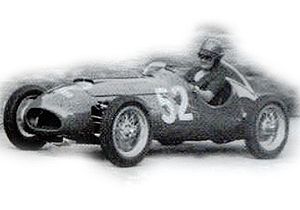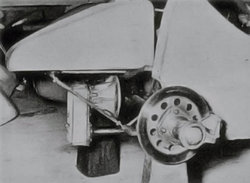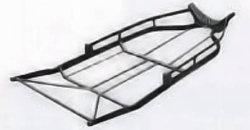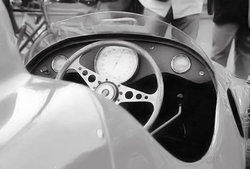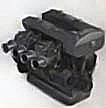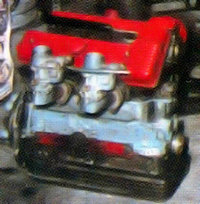Bandini formula 3
The Bandini formula three is a racing car model produced from 1954 until 1958 by the company Bandini Cars Forlì.
This type, produced at the same two-seater sports was born in order to participate in the category "race until 750 cm³" engine capacity which provided for the exclusive racing car use. This category gave birth to Formula Junior first, and the current formula three onwards; ereditiere purpose propedeutiche for future samples of specialties.
The characteristics that make important formula three (single-seater race 750) from the point of view of the historical Bandini are basically two: the unprecedented postponement of box ' transmission shaft and testing of disc brakes on four wheels.
The advantages of the latter were mainly limited solely to lower unsprung masses as the study of materials of seals of friction had not yet allow evolution that today poses this choice as a solution required the cars allocated to the races.
The box to postpone the transmission instead, a system was also used in subsequent formulajunior it offered a double advantage: making rapid replacement of two gears that determine the final drive ratio (allowing a rapid adaptation to the circuit) and, simultaneously, put significantly down the transmission shaft that conditioned to turn the position of the seat of the driver. This allowed a lowering of CG with the consequent improvement of road holding total of the car.
The racing debut occurred on July 1954 to the third edition of "Cup Louis Arcangeli," disputatasi on the Forlì circuit.
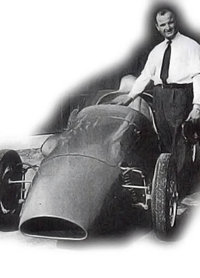
The same manufacturer Ilario Bandini, classified in second place in the race reserved for "single way up to 750 cm³" valid for the Italian championship.
The Chassis
The chassis keeps the characteristics, materials and design, used for torpedotwo-seater sports, but the size, necessarily lower a car, make it possible to further cut the weight that descends so only 16 kg.
- Structure and material: frame of elliptical section tubes, special steel aeronautics derivation; patent No. 499843
- Suspensions:
- Braking system:
- Service: hydraulics, drum front and rear, as an alternative hydraulic disc on four wheels
- Parking: not found
- Steering: a worm
- Guide: single, central location
- Wheels: ray Borrani
- Tank: 25 Litres
- Transmission: transmission shaft with joints cardanici, differential central position reversed and box with quick change of relations (6 reports available) and the semiassi rear
- Weight: bare chassis 16 kg
- Weight total: 300 kg
The Engine
The three Bandini formula used the same engines which powered the two-seater sports the same period: Bandini-Crosley first and second series, although the duration of lesser races for single-seater allowed the use of modifications and adjustments "pushes" as an increase in the compression ratio or the use of rods alloy.
- Positioning: forward longitudinal, 4-cylinder in-line
- Materials and particularity: base 5 media bench and league cup d 'aluminium of 5 litres capacity, head in aluminium [[bialbero] ] Gear with 8 valves inclined, cylinders dismantled in ironcasted block.
- Bore: 63.5 mm
- Stroke: 59 mm
- Displacemen: 747 cm ³
- Compression ratio: 11.2:1
- Power: 2 Weber carburetors double body 35DCO3 horizontal or vertical
- Power: 66 to 73 hp 9000 rpm
- Lubricate: Carter with wet gear pump and filter external wire mesh
- Cooling: forced liquid with centrifugal pump controlled by pulley and belt, cooler on the front
- Gearbox and clutch: 4 speed+ RG, clutch single dry disc
- Ignition and electrical equipment: coil and distributor switch on the head, battery 12 V and generator
The Body
The alloy body, made the Bandini were of two types; different especially on the front: a very similar to torpedo two-seater, with grid elements horizontal and vertical elliptical high and very rounded and the other lower and spigolosa with the air-intake front almost a semicircle. Both solutions were not welded to the body car but screwed to it, so as to enable the interchangeability as well as add convenience in the event of operations in the engine compartment or contacts to tender. As the front, the tail and side panels of the engine compartment were easily dismantled. They have openings in gills of sharks in the two positions in relation to the role: the air fresh or sfoghi of warm air). Their position reveals the use of different carburettors (horizontal or vertical). Almost always present instead sfoghi large rectangular body on the car, between the engine compartment and the cockpit, where the body is deeply dug. To protect aerodynamics of the driver, only a small "slide" or a windshield that wraps the whole but for a few centimeters in height. The tail, very short and at peak closed slightly above the rear axle at a point where goes also fin-rollbar, born immediately behind the driver.
Related Items
| Bandini Automobili | |
|---|---|
| Barchette: "La prima" 1100/46 | 1100 sport | 1100 Siluro (Torpedo) | Bandini-Maserati 1500 | 750 sport Siluro (Torpedo) | 750 sport internazionale "saponetta"
Formula: Formula 3 | Formula junior
|
